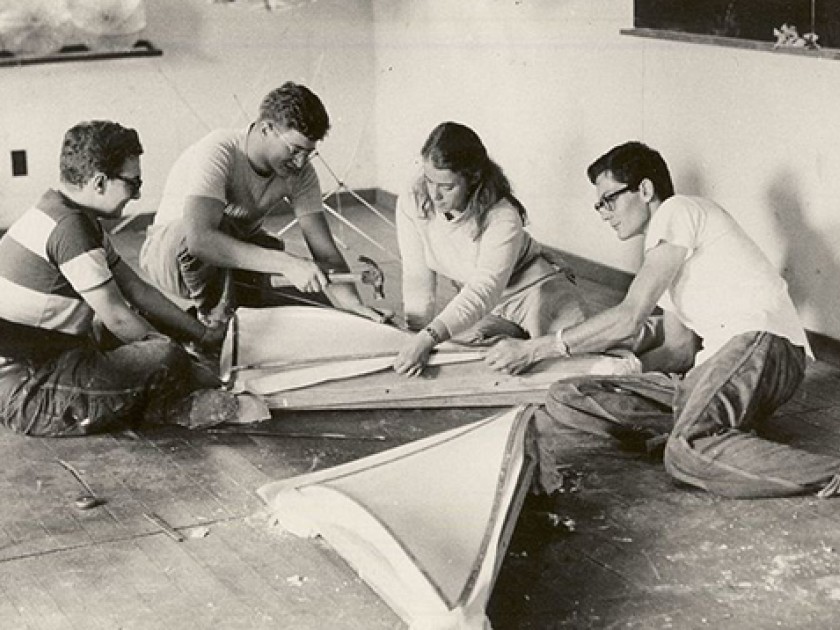
Interviewed in 1967, Josef Albers, nearing eighty, was asked why he had spent nearly two decades at a small liberal arts school in North Carolina, having previously been a Meister at the Bauhaus (and would later become head of the design department at Yale). After a measured pause, Albers replied, “My gratitude to Black Mountain, [that] they had saved us from the Nazis.” His wife, Anni, added quietly, “In fact, we had to leave because of my background.” On both counts, they were not alone.
Set up by a group of offbeat U.S. academics in 1933, Black Mountain College would offer a safe haven to fifty-two refugees from Nazi Germany, almost all of them Jews. One of these was Anni Albers. Her mother, Toni, was born into the powerful Ullstein publishing dynasty. Like her daughter, she was baptized a Protestant; such assimilative niceties were lost on the Nazis, however. Within weeks of Hitler taking power in January 1933, Germans of Jewish ancestry were banned from academia and the professions. The country’s avant-garde, too, came under attack. In April 1933, teachers at the Bauhaus arrived to find its gates locked and buildings taken over by the Gestapo. In July, the school’s director, Mies van der Rohe, closed it down. Four weeks later, Black Mountain College opened its doors in a wooden antebellum mansion outside Asheville, North Carolina.
The timing could not have been more perfect. As Ted Dreier, one of the school’s founders, recalled, Black Mountain was short an art teacher. He turned for advice to the architect Philip Johnson, then at the Museum of Modern Art. Johnson had visited an earlier iteration of the Bauhaus, at Dessau in Saxony. Aware of what was happening under Hitler, he suggested Dreier write to Josef Albers. Desperate to leave Germany, the ex-Bauhaus Meister and his weaver wife leapt at the offer of jobs at a school that was far away, poor, and tenuous. Neither had heard of North Carolina. Anni hazarded that it might be in the Philippines; Josef spoke no English. Nonetheless, on December 5, the pair stepped from a train to be picked up by the Dreiers in their Model A Ford. “GERMANS TO TEACH ART NEAR HERE,” announced an astonished Asheville Citizen.
At first, the Albers wondered what they had come to. A year earlier, another college had opened in Asheville: called Galahad, this preached the mystical Fascism of its founder, William Dudley Pelley, who agitated for Jews to be rounded up in ghettos. Black Mountain, seventeen miles from Asheville, kept its distance. So, too, from the mainstream of American academia. Jewish academics arriving at other U.S. institutions found their reception less than warm: the Classicist and philosopher Ernst Manasse recalled meeting with as much anti-Semitism in American universities as he had in German ones. Realizing their luck at having come to Black Mountain, the Albers set about getting their friends there: first, in 1935, the psychiatrists Fritz and Anna Moellenhoff, for whose Berlin flat Josef had designed furniture; then, in 1936, the dramatist and ex-Bauhausler Xanti Schawinsky. Jewish organizations took note of Black Mountain’s open door, and pressed it to take more refugees.
It obliged. In 1938 came the phenomenologist Erwin Straus, along with the former conductor of the Cologne opera, Heinrich Jalowetz, and his wife and daughter. They were joined by musicologist Edward Lowinsky and his violinist wife, Gretel; then by Fritz Cohen, founder of the Jooss Ballet company, and his wife, the dancer Elsa Kahl. In 1944, via Norway, Siberia and Japan, came noted mathematician Max Dehn. By the end of the Second World War, Black Mountain’s sixty students were matched, more or less head for head, by Jewish émigré teachers and their spouses and families. They made up what may have been the densest concentration of intellect in the United States.
It wasn’t only the staff’s eminence that made it extraordinary. So small were the college’s numbers and shallow its pockets that teachers were forced to double up on subjects: thus Max Dehn taught not just mathematics but Latin and Greek. This early experiment in what would later be called interdisciplinarity came to define Black Mountain. Staff as well as students benefited: Josef Albers sat in on Dehn’s math lessons, Dehn took Albers’s art course. After the war, American-born academics and artists would embrace Black Mountain’s blurring of boundaries: John Cage’s dance/art/drama Theatre Piece No. 1, considered to be the first Happening, was staged in the dining hall in 1952. By then, Dehn and Jalowetz were dead, buried in the college’s woods; the Albers had moved on to Yale, Schawinsky to Chicago. The German-Jewish colony in the Blue Ridge Mountains was ended, but not its significance.
Charles Darwent is an art critic and reviewer and author of the biography Josef Albers: Life and Work, published by Thames & Hudson (November 2018). He contributes regularly to the Guardian, the Art Newspaper and ArtReview. He appeared in the Netflix series, Raiders of the Lost Art, from 2014 to 2016. His publications include Mondrian in London and The Drawing Book: A Survey of Drawing.
Image via Wikimedia Commons